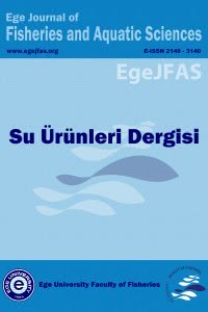Benefits of artificial reefs in Altınoluk (Northern Aegean), Turkey: Assessment of potential users' opinions via fuzzy pair wise comparison approach
Altınolukda (Kuzey Ege) yapay resiflerin faydaları: Bulanık eşli karşılaştırma yaklaşımı ile potansiyel kullanıcıların görüşlerinin değerlendirilmesi
___
Bell, F.W., Bonn, M.A., Leeworthy, V.R, 1998. Economic Impact and Importance of Artificial Reefs in Northwest Florida. NOAA Paper Contract Number MR235 Office of Fisheries Management and Assistance Service, Florida Department of Environmental Administration, Tallahassee, FL. 476 pp.Ditton, R.B., T.L. Baker, 1999. Demographics, Attitudes, Management Preferences, and Economic Impacts of Sport Divers using Artificial Reefs in Offshore Texas Waters. Report prepared for the Texas Parks and Wildlife Department through a research contract with Texas A&M University. 44 pp.
Ditton, R. B., Thailing, C.E. Riechers, R., H. Osburn, 2001. The Economic impacts of sport divers using Artificial Reefs in Texas Offshore Waters. In: 53rd Annual Gulf and Caribbean Fisheries Institute Meeting, Proceedings Book, 54: 349-360.
Ditton R.B., Osburn, H.R., Baker, T.L., Thailing C.E., 2002. Demographics, attitudes, and reef management preferences of sport divers in offshore Texas waters. ICES Journal of Marine Science, 59: 186S191. doi: 10.1006/jmsc.2002.1188
Düzbastılar, F.O., Tokaç, A., 2003. Determination of effects of artificial reef size on local scouring phenomena resulting from wave action Ege Journal of Fisheries and Aquatic Science,20 (3-4): 373 381.
Greene, W., 2003. Econometric Analysis. 5th ed. Prentice Hall, New Jersey. 206p.
Gujarati, N.D., 2008. Basic Econometrics. 5th ed. McGraw-Hill, USA. 944p.
Günden, C., Miran, B., 2007. A Research on the Determination of Farmers Objectives Hierarchy Using Fuzzy Pairwise Comparison. Akdeniz University Journal of Agricultural Faculty, 20 (2), 183-191.
Günden, C., Miran, B., Uysal Ö.K., Bektaş Z.K., 2008. An Analysis of Consumer Preferences for Information Sources on Food Safety by using Fuzzy Pair-Wise Comparison. Southern Agricultural Economics Association Annual Meeting, Dallas, TX, 17 p.
Lök, A., 1995. Yapay resiflerin uygulanabilirliği üzerine bir araştırma. Doctor of Philosophy Dissertation. Ege University Press Bornova, İzmir, 55 p.
Lök, A., Gül, B., 2005. Evaluation of fish fauna associated with experimental artificial reefs in Hekim Island in Izmir Bay (Aegean Sea, Turkey). Ege Journal of Fisheries and Aquatic Sciences, 22 (1-2): 109-114.
Lök A., 2012. Artificial reef applications in Turkey. Report of the 12th Session of the Sub-Committee on Marine Environment and Ecosystems (SCMEE), GFCM, FAO HQs, Rome, Italy, 23-26 January 2012, 23 p.
Milon, J.W., Holland, S.M., Whitmarsh, D.J., 2000. Social and Economic Evaluation Methods, In: Artificial Reef Evaluation with Application to Natural Marine Habitats, W.Jr. Seaman (Ed.), CRC Press LLC, Florida, pp. 165-194.
Miran B., 2003. Basic Statistics. Ege University Press, ISBN 975-9308800, Bornova, İzmir, 297 p.
Morgana, O.A., Massey, D.M., Huth, W.L., Hall, R., 2009. Demand for Diving on Large Ship Artificial Reefs. Marine Resource Economics, 24: 43-59.
Oh, C, Ditton, R.B., Stoll, J.R., 2008. The Economic Value of Scuba-Diving Use of Natural and Artificial Reef Habitats. Society & Natural Resources, 21: 455-468. doi: 10.1080/08941920701681953
Pendleton, L.H., 2004. Creating Underwater Value: The Economic Value of Artificial Reefs for Recreational Diving, California Artificial Reef Enhancement Program. Prepared for: The San Diego Oceans Foundation. 11p.
Ramanathan, R., 1998. Introductory Econometrics with Applications. The Dryden Press, USA, 664p.
Tiryakioğlu, F.Ö., 2008. Socio-Economic Evaluation Of Artificial Reefs In Aegean Sea, Turkey. University of Portsmouth Business School, Master of Science Dissertation, Portsmouth, UK, 41 p.
Tunca, 2011. Assessing Socio-Economic Effects of Artificial Reef Deployments in the Northern Aegean Sea: Altınoluk Case. Ege University Graduate School of Natural and Applied Sciences, Department of Agricultural Economics, Master of Science Thesis, 172 p.
Tunca, S., Miran, B., Ünal, V., 2012. Decisions of Stakeholders for the Proposed Artificial Reef Deployment: Analytic Hierarchy Process Approach. Ege Journal of Fisheries and Aquatic Science, 29 (1). doi: 10.12714/egejfas.2012.29.1.04
Turkish Statistical Institute (TSI), 2011. The Results of Address Based Population Registration System. www.tuik.gov.tr.
Ulaş, A., 2007. A pre-study for determining of efficiency of fish sampling methods on artificial reefs. Ege Journal of Fisheries and Aquatic Sciences 24(3-4): 287293.
Ünal, V., Göncüoğlu, H., Yercan, M., 2009. Fishery Cooperatives along the Aegean Sea Coast (in Turkish with English summary), Publication of SÜRKOOP-Central Union of Fishery Cooperative Associations. No: 1, Ankara, 131p.
- ISSN: 1300-1590
- Yayın Aralığı: 4
- Başlangıç: 1984
- Yayıncı: Aynur Lök
Kabuklu deniz hayvanlarından kaynaklanan paralitik zehirlenme
Yağmur Nil DEMİREL, T.Halük ÇELİK
M. Tolga TÜZEN, TEVFİK CEYHAN, Okan AKYOL, C. Mert ÖZKAN
Erdal YILMAZ, ŞEHRİBAN ÇEK YALNIZ, YAVUZ MAZLUM
Sübye [Sepia officinalis (Linneaus, 1758)]'nin iç kabuk gelişimi
Dioktil adipat (DOA) 'ın Sparus aurata (Çipura) karaciğer ve solungaç histolojisi üzerine etkileri
Melih ÜRETEN, SEMA İŞİSAĞ ÜÇÜNCÜ
Some potentially toxic dinoflagellate cysts in recent sediments from İzmir bay
Karadeniz'in Sinop kıyılarından yakalanan bazı deniz balıklarının metazoan parazitleri
Ahmet ÖZER, Ahmet Murat OLGUNER
